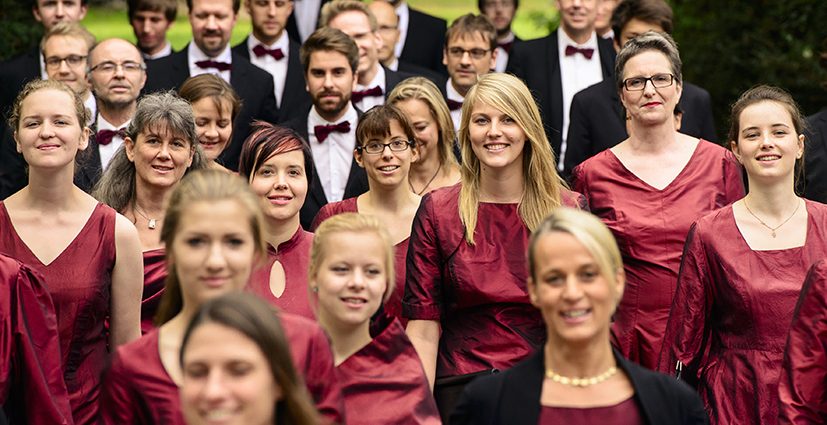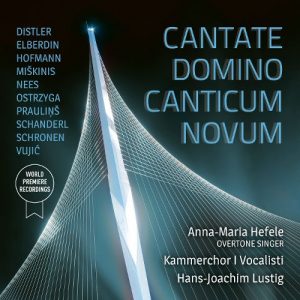Par T. J. Harper, D.M.A. chef de chœur et professeur
Cantate Domino Canticum Novum
Kammerchor I Vocalisti
Anna-Maria Hefele, soliste, interprète de chant harmonique
Hans-Joachim Lustig, Direction
Église de Stephansstift à Hanovre
(2016; 73’ 09”)
C’est un événement rare lorsqu’un nouvel enregistrement choral réussit à célébrer un thème commun où chaque performance se caractérise à la fois par de la vigueur et de la substance. Ceci est particulièrement rare lorsque le thème commun en question tourne autour d’un concept textuel singulier. Dans le Cantate Domino Canticum Novum, le chef Hans-Joachim Lustig a réussi avec brio à atteindre cet objectif avec son Kammerchor I Vocalisti et la soliste Anna-Maria Hefele. Enregistrée entre mars et juillet 2016 à l’église du Stephansstift à Hanovre, cette dernière prestation de Hans-Joachim Lustig est un mélange éclectique de compositions des XXème et XXIème siècles qui utilisent le même texte issu de trois traditions linguistiques différentes: “Sing to the Lord a new song[1]”, “Cantate Domino canticum novum”, et “Singet dem Herrn ein neues Lied”

Ancré dans l’histoire récente, le thème commun de ce CD, Cantate Domino Canticum Novum, tire une grande partie de son énergie esthétique et spirituelle du lied d’Hugo Distler Singet dem Herrn ein neues Lied[2], composé en 1934. Influencé par les techniques de composition d’Heinrich Schütz et de Jean-Sébastien Bach, Lustig permet à l’œuvre de Distler de placer fermement au centre de cet enregistrement la longue tradition de musique d’église.
Au cœur de cette collection de “chants nouveaux” se trouve également la voix unique et puissante de la soliste Anna-Maria Hefele. Après des études supérieures à l’Institut Carl Orff au Mozarteum Salzburg et au Deutches Museum München, elle se spécialise dans le chant harmonique, une technique vocale qui consiste à filtrer et à amplifier les harmoniques naturels dans la voix, de telle sorte que cela sonne comme si l’interprète chantait deux notes en même temps. Dans les compositions d’Uģis Prauliņš (1957), de Hans Schanderl (1960) et de Michael Ostrzyga (1975), Anna-Maria Hefele fournit une nouvelle couche sonore à la fois enivrante, musicale et remarquablement sensible à chacune des trois compositions dans lesquelles elle intervient.
Fondé en 1991, le Kammerchor I Vocalisti est composé de chanteurs venus du nord de l’Allemagne. Ils se sont produits sur la scène internationale et ont remporté le premier prix au 6ème Deutcher Chorwettbewerb en 2002, au Concours international de chœur de chambre à Tolosa en Espagne en 2004, et au Concours international de chœurs à Cork en Irlande en 2009. Leur chef, Hans-Joachim Lustig, est un chef de chœur indépendant qui dirige le Chorknaben Uetersen et anime des séminaires de direction de chœur dans toute l’Europe.
- Cantate Domino, d’Uģis Prauliņš (né en 1957), a été composé en 2015 et est un motet sur le Psaume 98 pour chœur à 8 voix et chant harmonique par une soliste. Dans cette œuvre, Prauliņš crée une fusion exceptionnelle de la vocalisation moderne chorale classique avec l’expression harmonique.
- Singet dem Herrn, de Vic Nees (1933-2013), a été écrit en 2002 pour chœur à 4-6 voix et soprano solo. Cette adaptation du Psaume 98 apporte un regard rafraîchissant sur les éloges lumineux et exclamatifs proposés dans ce texte.
- … Singet … de Thomas Hofmann (1958). Composé en 2000, ce motet pour deux chœurs à 4 voix est un prélude approprié à Singet dem Herrn de Distler; cette œuvre permet à la déclamation du texte d’être l’inspiration principale. Hofmann déclare: “En choisissant mes ressources de composition et avec tous les moyens allégoriques appropriés sous la forme d’une apothéose, il fallait clarifier la forme musicale avec une conclusion ouverte”.
- Singet dem Herr ein neues Lied op. 12 N°1 de Hugo Distler (1908-1942) est la pièce maîtresse historique de cet enregistrement, et est traitée avec beaucoup de sophistication et de clarté. Le langage musical de cette œuvre composée en 1934 est fortement influencé par le texte, et a une connexion à Heinrich Schütz. “De cette façon, nous énonçons clairement que le texte du psaume du titre a une longue tradition dans la musique d’église.” (Hans-Joachim Lustig)

Hans-Joachim Lustig - Cantate Domino de Josu Elberdin (1976) est un motet associant les textes des Psaumes 96 et 98 pour un chœur à huit voix. Composée en 2011, cette œuvre se caractérise par des quartes, des quintes et des octaves parallèles où les voix des hommes et des femmes travaillent indépendamment pour interagir ensemble avant le tutti. Cette pièce est également unique du fait que son texte est rédigé en partie en euskara, langue de la région d’origine du compositeur basque.
- Cantate Domino de Hans Schanderl (1960), pour chœur à huit voix et chant harmonique pour voix solo a été composé en 2016. Des extraits du Psaume 96 sont utilisés en répétition, associés à des syllabes phonétiques, et incitent à une improvisation harmonique magistrale. “Pour moi, le ton fondamental de cette composition était la pensée d’une expression de joie, dans le sens d’une sorte d’hymne à la jubilation qui se développe dans un style qui ressemble à une danse au sein de la texture musicale.” (Hans Schanderl)
- Singet dem Herr ein neues Lied, par Aleksandar S. Vujić (1945), est basé sur le texte du Psaume 149 ; cette œuvre pour 16 voix est un hommage à J. S. Bach. Le compositeur serbe Vujić affirme : “Mon idée était de suivre l’exemple de Bach, mais en ajoutant quelque chose de nouveau, quelque chose qui lui donnerait un nouvel élan. Ce faisant, je me suis borné à utiliser une seule dimension. J’ai choisi des rythmes irréguliers, typiques des Balkans, mais j’ai conservé et appliqué les principes des doubles chœurs des œuvres chorales de Bach: la polyphonie, l’homophonie et l’imitation. Je ne voulais pas trouver des sons extrêmement modernes, et je me suis donc consciemment posé des limites.”
- Cantate Domino, de Vytautas Miškinis (1954), exsude un éclat artistique qui correspond au texte et au contexte. Cette œuvre est séduisante pour son style chaleureux et harmonieux.
- Canticum Novum (… ab extremis terrae), de Michael Ostrzyga (1975), a été composé en 2015/2016 pour le Kammerchor I Vocalisti et un soliste harmonique. “La composition se déplace entre différentes dimensions : musique sans texte, récitations sans musique, sémantique et phonétique, déconstruction et reconstruction, clarté et brouillage, bruit et note, nuances et harmonies, concret et transfiguré, advenir et disparaître”. Une œuvre composée d’extrêmes. “Les mots ‘ab extremis terrae’ (des extrémités de la terre, Isaïe 42:10) sont restés dans mon esprit dès le début avec un sens différent du sens initial, même si ce n’est probablement pas ce qui est indiqué dans le contexte du passage de la Bible : comme une jonction entre le monde terrestre matériel et le monde extraterrestre immatériel. Pour cette raison, j’ai décidé d’utiliser seulement le début du texte et de le libérer du contexte concret.” (Michael Ostrzyga)
- Cantate Domino, d’Alwin Michael Schronen (1965). Composé en 2015, ce morceau se réfère sans équivoque aux harmonies et au style caractéristique de la musique vocale contemporaine des Pays baltes. “Le texte exprime une grande joie. J’ai traduit ceci dans la composition au moyen d’une mesure ternaire, et d’une disposition en double chœur avec un chœur de femmes à trois voix et un chœur d’hommes à trois voix”. La structure des textures homophoniques superposées des voix masculines et féminines est unique.
Traduit de l’anglais par Barbara Pissane (France)
[1] NdlT : Chantez au Seigneur un chant nouveau
[2] NdlT : Chantez au Seigneur un chant nouveau


